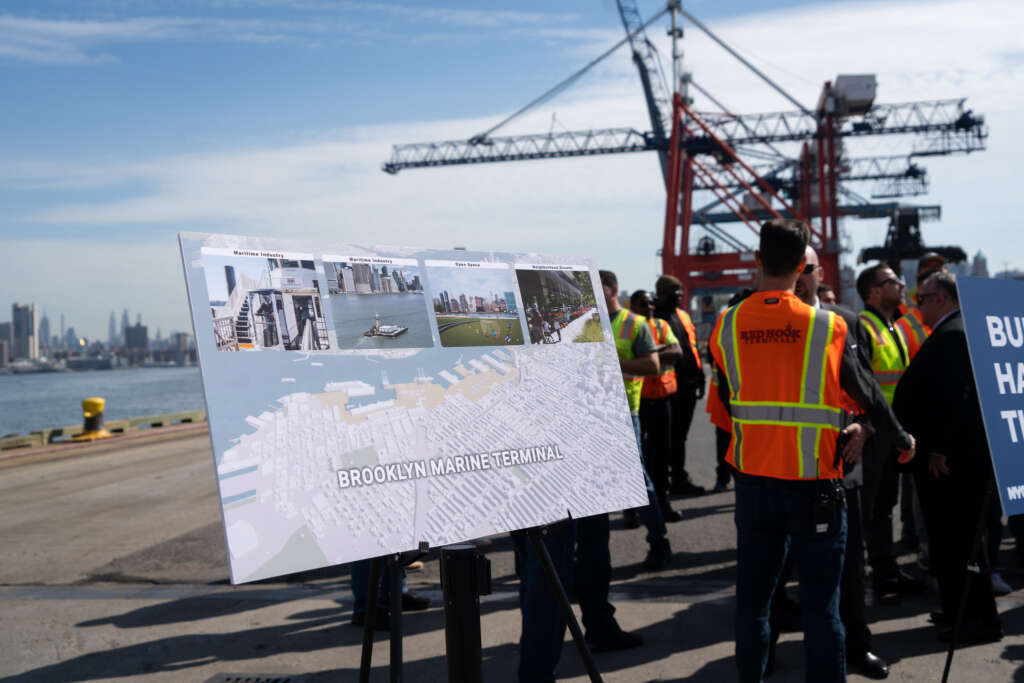“New York City needs to show it can build housing that isn’t prohibitively expensive and comes in without years of delay. EDC can help get it done at the Brooklyn Marine Terminal.”
City and state officials announcing plans to redevelop Red Hook’s Brooklyn Marine Terminal last year. (Caroline Rubinstein-Willis/Mayoral Photography Office)
New York City has a crushing housing shortage. With federal housing subsidies on the chopping block, the city needs competent organizations like the Economic Development Corporation (EDC) to step in and quickly scale up affordable housing at public sites like the Brooklyn Marine Terminal.
In recent years, EDC has helped deliver 560 affordable units to the Lower East Side as part of the Essex Crossing redevelopment, 740 affordable units to the South Bronx at the former Spofford Juvenile Detention Center, and an impressive 2,500 affordable units are underway at Willets Point in Queens.
Now, EDC is attempting to revitalize the Brooklyn Marine Terminal, a decaying 122-acre waterfront site in Red Hook. Last year, the city agreed to take operating control of the terminal. The redevelopment vision calls for modernizing the container port and piers—half out of service or nearing the end of their useful lives—as part of a “Blue Highway” supply chain that moves freight around the city by water instead of trucks.
One scenario under consideration includes around 8,000 housing units, roughly 35 percent permanently affordable, new public parks around the waterfront, retail and commercial options, and expanded bus and ferry service to transit-starved Red Hook.
There is an opportunity to advance the Brooklyn Marine Terminal project at a pace New Yorkers wouldn’t have been able to fathom a few years ago. That’s in part thanks to the leadership of a Task Force, chaired by U.S. Rep. Dan Goldman, that has guided the development of the plan.
EDC has held numerous meetings with community groups, reaching over 3,000 neighborhood residents. Red Hook West Tenant Association President Karen Blondel, a longtime advocate for NYCHA residents, has endorsed the project, saying, “We have an opportunity to create a more equitable Red Hook and I hope we seize the moment.”
Nevertheless, the Brooklyn Marine Terminal project has generated significant opposition from some community residents, lawmakers and others concerned about the reduced port area, waterfront job losses, gentrification and other impacts of dense housing. A local coalition, “Voices of the Waterfront,” has called for a pause to the general project plan process, and for it to undergo the city’s Uniform Land Use Review Procedure (ULURP) to allow for more community engagement.
This risks making it more expensive to build and could derail the affordable housing component.
Separating housing from the broader redevelopment project would be a missed opportunity, as a port built a century ago can more efficiently handle today’s cargo on a much smaller land area.
Delaying the project for ULURP would also raise costs, just as Donald Trump’s tariffs kick in and push construction prices even higher, and is not guaranteed to produce better projects—just look at Hudson Yards. Scuttling the project would be another blow to addressing the city’s housing crisis.
Community leaders should continue negotiating directly with EDC for a limited, defined period and push for specific public benefits, such as more frequent bus and ferry service to Red Hook and protections against flooding and rising sea levels. However, keeping EDC at the helm is worth the squeeze. EDC answers to city control, builds fast and well, and has earned trust through projects like Willets Point and Spofford.
EDC-led projects have relied on private sector capital and efficiencies to create projects with public benefits, including permanent affordable housing, parks, job training, ferry service, and community centers. EDC’s mixed-use approach is distinct from many affordable housing projects of the past, which often isolated residents in large towers.
New York City needs to show it can build housing that isn’t prohibitively expensive and comes in without years of delay. EDC can help get it done at the Brooklyn Marine Terminal.
Nicholas Bloom is a professor of urban policy and planning at Hunter College. He is the author of “Public Housing That Worked: New York in the Twentieth Century” and co-editor of “Affordable Housing in New York.“
The post Opinion: The Brooklyn Marine Terminal Can Help Solve NYC’s Housing Shortage appeared first on City Limits.

